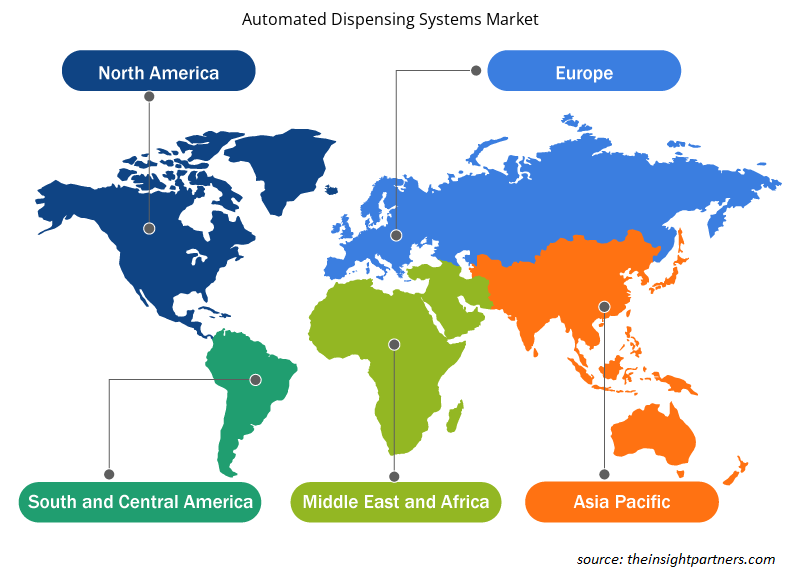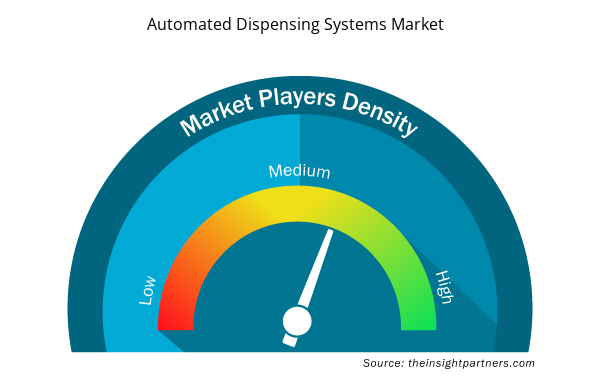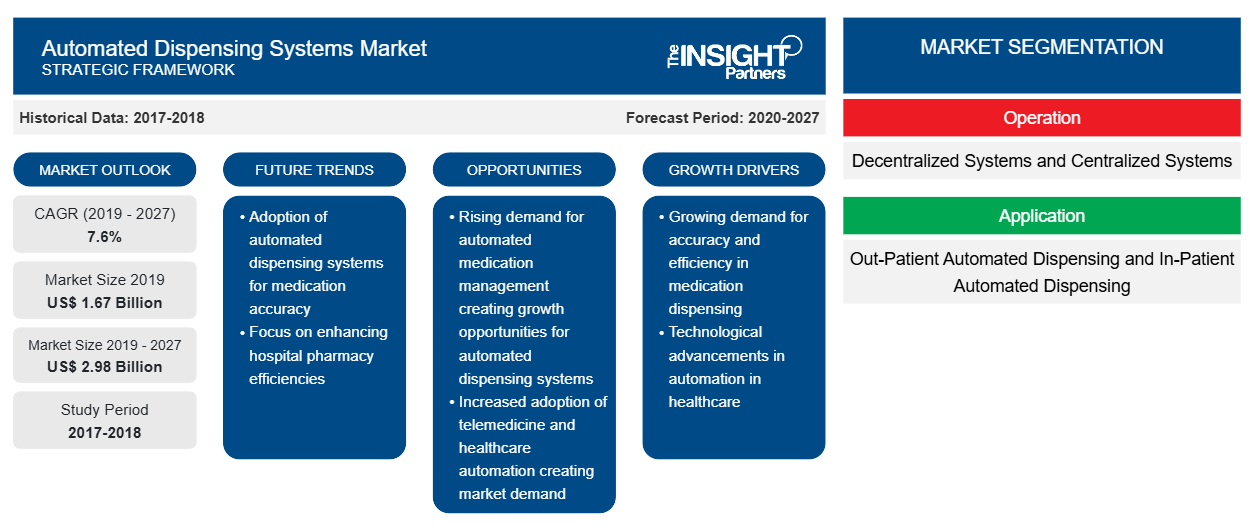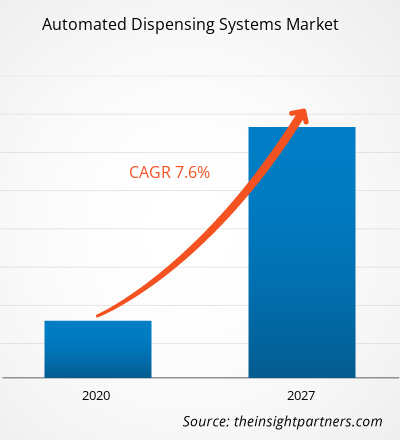من المتوقع أن يصل سوق أنظمة التوزيع الآلية إلى 2،980.38 مليون دولار أمريكي بحلول عام 2027 من 1،665.78 مليون دولار أمريكي في عام 2019؛ ومن المتوقع أن ينمو بمعدل نمو سنوي مركب قدره 7.6٪ خلال الفترة 2020-2027.
تُعَد أنظمة التوزيع الآلي، والتي تُعرف أيضًا باسم خزائن الأدوية الآلية، أجهزة إلكترونية لتخزين الأدوية وتوزيعها، وتُستخدم في المقام الأول في بيئات الرعاية الصحية. تساعد هذه الأنظمة في تتبع وتوزيع الأدوية؛ فهي مؤمنة بكلمات مرور موثقة وبيانات حيوية للتحكم في المخزون وتأمين الأدوية ضد السرقة. وقد تم تسليط الضوء على هذه الأنظمة كواحدة من الأدوات المحتملة لتحسين الكفاءة التشغيلية وسلامة المرضى. وعلاوة على ذلك، تُستخدم الآن على نطاق واسع في العيادات ودور التمريض، من بين أمور أخرى. تساعد أنظمة التوزيع الآلي في تحويل المستشفيات إلى مؤسسات أكثر أمانًا وكفاءة وفعالية.
إن سوق أنظمة التوزيع الآلي العالمية مدفوع بعوامل مثل زيادة أخطاء الأدوية وارتفاع عدد السكان المسنين. ومع ذلك، فإن المشاكل المرتبطة بأنظمة التوزيع الآلي مثل إدخال البرنامج الخاطئ وتعطل المعدات وغيرها قد تعيق نمو السوق. بالإضافة إلى ذلك، تخلق الأسواق الناشئة فرص نمو للاعبين في السوق.
قم بتخصيص هذا التقرير ليناسب متطلباتك
ستحصل على تخصيص لأي تقرير - مجانًا - بما في ذلك أجزاء من هذا التقرير، أو تحليل على مستوى الدولة، وحزمة بيانات Excel، بالإضافة إلى الاستفادة من العروض والخصومات الرائعة للشركات الناشئة والجامعات
- احصل على أهم اتجاهات السوق الرئيسية لهذا التقرير.ستتضمن هذه العينة المجانية تحليلاً للبيانات، بدءًا من اتجاهات السوق وحتى التقديرات والتوقعات.
رؤى السوق
تزايد أخطاء الأدوية
قد يؤدي صرف الأدوية بشكل غير عقلاني وغير مناسب وغير فعال إلى أخطاء دوائية خطيرة يمكن أن تضر بالمرضى. ومن بين الأخطاء الدوائية الشائعة صرف دواء خاطئ، أو صرف كمية خاطئة من الدواء، أو صرف دواء بتركيز خاطئ، أو حذف عنصر. ~75% من أخطاء الأدوية ناجمة عن تشتيت الانتباه، حيث ينشغل أخصائيو الرعاية الصحية بمهام متعددة مثل فحص المرضى، والتحدث إلى الاستشاريين، والتحدث إلى أفراد أسرة المريض، والتحدث إلى متخصصي التأمين.
تتلقى إدارة الغذاء والدواء الأمريكية سنويًا أكثر من 100000 تقرير مرتبط بخطأ في تناول الأدوية. وعلاوة على ذلك، وفقًا لدراسة "أخطاء الأدوية" المنشورة في StatPearls في يونيو 2020، يموت كل عام حوالي 7000-9000 شخص بسبب خطأ في تناول الأدوية في الولايات المتحدة. وبالمثل، وفقًا للتقديرات المنشورة في دراسة "انتشار وعبء أخطاء الأدوية الاقتصادي في هيئة الخدمات الصحية الوطنية في إنجلترا" في عام 2018، يحدث كل عام حوالي 237 مليون خطأ في تناول الأدوية في هيئة الخدمات الصحية الوطنية وتؤدي الآثار الجانبية للأدوية التي يمكن تجنبها إلى مئات الوفيات.
رؤى مبنية على العمليات
بناءً على التشغيل، يتم تقسيم سوق أنظمة التوزيع الآلي إلى أنظمة لامركزية وأنظمة مركزية. احتل قطاع الأنظمة المركزية حصة أكبر من السوق في عام 2019 بسبب عوامل مثل الحاجة المتزايدة إلى خفض التكاليف وضمان توفر الأدوية وتحديث تخصيص الموارد. علاوة على ذلك، من المتوقع أن يسجل النظام اللامركزي معدل نمو سنوي مركب أكبر في السوق خلال فترة التنبؤ.
رؤى قائمة على التطبيق
بناءً على التطبيق، يتم تقسيم سوق أنظمة التوزيع الآلي إلى توزيع آلي للمرضى الداخليين وتوزيع آلي للمرضى الخارجيين. استحوذ قطاع التوزيع الآلي للمرضى الداخليين على حصة أكبر من السوق في عام 2019؛ ومع ذلك، من المتوقع أن يسجل التوزيع الآلي للمرضى الخارجيين معدل نمو سنوي مركب أعلى خلال فترة التنبؤ.
رؤى تعتمد على المستخدم النهائي
بناءً على المستخدم النهائي، يتم تقسيم سوق أنظمة التوزيع الآلي إلى صيدليات المستشفيات وصيدليات التجزئة وغيرها. استحوذ قطاع صيدليات المستشفيات على أكبر حصة من السوق في عام 2019؛ ومع ذلك، من المتوقع أن يسجل قطاع صيدليات التجزئة أعلى معدل نمو سنوي مركب في السوق خلال الفترة المتوقعة.
تعد عمليات إطلاق المنتجات والموافقة عليها من الاستراتيجيات التي تتبناها الشركات بشكل شائع لتوسيع نطاق وجودها العالمي ومحافظ منتجاتها؛ وتساعدها هذه الاستراتيجيات على تلبية الطلب المتزايد من المستهلكين. يعد التعاون أحد الاستراتيجيات الرئيسية التي يتبناها لاعبو سوق أنظمة التوزيع الآلي لتوسيع قاعدة العملاء في جميع أنحاء العالم، مما يسمح لهم أيضًا بالحفاظ على اسم علامتهم التجارية عالميًا.
رؤى إقليمية حول سوق أنظمة التوزيع الآلي
لقد قام المحللون في Insight Partners بشرح الاتجاهات والعوامل الإقليمية المؤثرة على سوق أنظمة التوزيع الآلي طوال فترة التوقعات بشكل شامل. يناقش هذا القسم أيضًا قطاعات سوق أنظمة التوزيع الآلي والجغرافيا في جميع أنحاء أمريكا الشمالية وأوروبا ومنطقة آسيا والمحيط الهادئ والشرق الأوسط وأفريقيا وأمريكا الجنوبية والوسطى.

- احصل على البيانات الإقليمية المحددة لسوق أنظمة التوزيع الآلي
نطاق تقرير سوق أنظمة التوزيع الآلي
| سمة التقرير | تفاصيل |
|---|---|
| حجم السوق في عام 2019 | 1.67 مليار دولار أمريكي |
| حجم السوق بحلول عام 2027 | 2.98 مليار دولار أمريكي |
| معدل النمو السنوي المركب العالمي (2019 - 2027) | 7.6% |
| البيانات التاريخية | 2017-2018 |
| فترة التنبؤ | 2020-2027 |
| القطاعات المغطاة | حسب العملية
|
| المناطق والدول المغطاة | أمريكا الشمالية
|
| قادة السوق وملفات تعريف الشركات الرئيسية |
|
كثافة اللاعبين في سوق أنظمة التوزيع الآلي: فهم تأثيرها على ديناميكيات الأعمال
يشهد سوق أنظمة التوزيع الآلي نموًا سريعًا، مدفوعًا بالطلب المتزايد من المستخدم النهائي بسبب عوامل مثل تفضيلات المستهلكين المتطورة والتقدم التكنولوجي والوعي المتزايد بفوائد المنتج. ومع ارتفاع الطلب، تعمل الشركات على توسيع عروضها والابتكار لتلبية احتياجات المستهلكين والاستفادة من الاتجاهات الناشئة، مما يؤدي إلى زيادة نمو السوق.
تشير كثافة اللاعبين في السوق إلى توزيع الشركات أو المؤسسات العاملة في سوق أو صناعة معينة. وهي تشير إلى عدد المنافسين (اللاعبين في السوق) الموجودين في مساحة سوق معينة نسبة إلى حجمها أو قيمتها السوقية الإجمالية.
الشركات الرئيسية العاملة في سوق أنظمة التوزيع الآلية هي:
- شركة آبفي
- أبوت
- شركة ف. هوفمان-لاروش المحدودة
- شركة بريستول مايرز سكويب
- خدمات جونسون آند جونسون، المحدودة
إخلاء المسؤولية : الشركات المذكورة أعلاه ليست مرتبة بأي ترتيب معين.

- احصل على نظرة عامة على أهم اللاعبين الرئيسيين في سوق أنظمة التوزيع الآلي
السوق العالمية لأنظمة التوزيع الآلي - حسب العملية
- الأنظمة اللامركزية
- الأنظمة المركزية
السوق العالمية لأنظمة التوزيع الآلي – حسب التطبيق
- صرف الأدوية آليًا للمرضى الخارجيين
- صرف الأدوية آليًا للمرضى الداخليين
السوق العالمية لأنظمة التوزيع الآلي - حسب المستخدم النهائي
- صيدليات التجزئة
- صيدليات المستشفيات
- آحرون
سوق أنظمة التوزيع الآلي – حسب المنطقة الجغرافية
أمريكا الشمالية
- نحن
- كندا
- المكسيك
أوروبا
- فرنسا
- ألمانيا
- إيطاليا
- المملكة المتحدة
- إسبانيا
- بقية أوروبا
آسيا والمحيط الهادئ (APAC)
- الصين
- الهند
- كوريا الجنوبية
- اليابان
- أستراليا
- بقية آسيا والمحيط الهادئ
الشرق الأوسط وأفريقيا
- جنوب أفريقيا
- المملكة العربية السعودية
- الامارات العربية المتحدة
- بقية الشرق الأوسط وأفريقيا
أمريكا الجنوبية والوسطى
- البرازيل
- الأرجنتين
- بقية أمريكا الجنوبية
نبذة عن الشركة
- شركة سيرنر
- كابسا للرعاية الصحية
- شركة أومنيسيل
- بنغلاديش
- أركسيوم
- شركة أكيو تشارت بلس للأنظمة الصحية
- شركاء الابتكار
- شركة RxMedic Systems
- شركة سويس لوج القابضة المحدودة
- شركة Willach Pharmacy Solutions GmbH
- التحليل التاريخي (سنتان)، السنة الأساسية، التوقعات (7 سنوات) مع معدل النمو السنوي المركب
- تحليل PEST و SWOT
- حجم السوق والقيمة / الحجم - عالميًا وإقليميًا وقطريًا
- الصناعة والمنافسة
- مجموعة بيانات Excel


- Automotive Fabric Market
- Medical Collagen Market
- Wind Turbine Composites Market
- Microplate Reader Market
- GMP Cytokines Market
- Arterial Blood Gas Kits Market
- Vision Guided Robotics Software Market
- Dealer Management System Market
- Personality Assessment Solution Market
- Airline Ancillary Services Market

Report Coverage
Revenue forecast, Company Analysis, Industry landscape, Growth factors, and Trends

Segment Covered
This text is related
to segments covered.

Regional Scope
North America, Europe, Asia Pacific, Middle East & Africa, South & Central America

Country Scope
This text is related
to country scope.
الأسئلة الشائعة
The anti-viral therapiesmarket majorly consists of the players such as Cerner Corporation, Capsa Healthcare, Omnicell, Inc, BD, ARxIUM, Accu-Chart Plus Healthcare Systems, Inc, Innovation Associates, RxMedic Systems, Inc, Swiss log Holding Ltd and Willach Pharmacy Solutions GmbHamongst others.
The factors that are driving growth of the market are increasing medication errors, increasing prevalence of chronic diseases and rising geriatric population. Moreover, emerging markets is expected to offer lucrative opportunities for the growth of the market.
Automated dispensing system, also termed as automated drug cabinet, is an electronic drug storage and dispensing device primarily used in health care settings. These systems aid in tracking and controlling the drug distribution and are secured with authenticated passwords and biometrics for inventory control and security of the drugs. These systems have been recommended as one of the potential instruments to improve efficiency and patient safety, and they are now widely used in many hospitals, for instance in clinics, nursing homes. Automated dispensing system helps to transform hospitals into safer, more efficient and more effective institutions.
The List of Companies - Automated Dispensing Systems Market
- AbbVie Inc.
- Abbott
- F. Hoffmann-La Roche Ltd
- Bristol-Myers Squibb Company
- Johnson & Johnson Services, Inc.
- Merck and Co., Inc.
- Gilead Sciences, Inc.
- GlaxoSmithKline plc
- Aurobindo Pharma
- AstraZeneca
The Insight Partners performs research in 4 major stages: Data Collection & Secondary Research, Primary Research, Data Analysis and Data Triangulation & Final Review.
- Data Collection and Secondary Research:
As a market research and consulting firm operating from a decade, we have published and advised several client across the globe. First step for any study will start with an assessment of currently available data and insights from existing reports. Further, historical and current market information is collected from Investor Presentations, Annual Reports, SEC Filings, etc., and other information related to company’s performance and market positioning are gathered from Paid Databases (Factiva, Hoovers, and Reuters) and various other publications available in public domain.
Several associations trade associates, technical forums, institutes, societies and organization are accessed to gain technical as well as market related insights through their publications such as research papers, blogs and press releases related to the studies are referred to get cues about the market. Further, white papers, journals, magazines, and other news articles published in last 3 years are scrutinized and analyzed to understand the current market trends.
- Primary Research:
The primarily interview analysis comprise of data obtained from industry participants interview and answers to survey questions gathered by in-house primary team.
For primary research, interviews are conducted with industry experts/CEOs/Marketing Managers/VPs/Subject Matter Experts from both demand and supply side to get a 360-degree view of the market. The primary team conducts several interviews based on the complexity of the markets to understand the various market trends and dynamics which makes research more credible and precise.
A typical research interview fulfils the following functions:
- Provides first-hand information on the market size, market trends, growth trends, competitive landscape, and outlook
- Validates and strengthens in-house secondary research findings
- Develops the analysis team’s expertise and market understanding
Primary research involves email interactions and telephone interviews for each market, category, segment, and sub-segment across geographies. The participants who typically take part in such a process include, but are not limited to:
- Industry participants: VPs, business development managers, market intelligence managers and national sales managers
- Outside experts: Valuation experts, research analysts and key opinion leaders specializing in the electronics and semiconductor industry.
Below is the breakup of our primary respondents by company, designation, and region:

Once we receive the confirmation from primary research sources or primary respondents, we finalize the base year market estimation and forecast the data as per the macroeconomic and microeconomic factors assessed during data collection.
- Data Analysis:
Once data is validated through both secondary as well as primary respondents, we finalize the market estimations by hypothesis formulation and factor analysis at regional and country level.
- Macro-Economic Factor Analysis:
We analyse macroeconomic indicators such the gross domestic product (GDP), increase in the demand for goods and services across industries, technological advancement, regional economic growth, governmental policies, the influence of COVID-19, PEST analysis, and other aspects. This analysis aids in setting benchmarks for various nations/regions and approximating market splits. Additionally, the general trend of the aforementioned components aid in determining the market's development possibilities.
- Country Level Data:
Various factors that are especially aligned to the country are taken into account to determine the market size for a certain area and country, including the presence of vendors, such as headquarters and offices, the country's GDP, demand patterns, and industry growth. To comprehend the market dynamics for the nation, a number of growth variables, inhibitors, application areas, and current market trends are researched. The aforementioned elements aid in determining the country's overall market's growth potential.
- Company Profile:
The “Table of Contents” is formulated by listing and analyzing more than 25 - 30 companies operating in the market ecosystem across geographies. However, we profile only 10 companies as a standard practice in our syndicate reports. These 10 companies comprise leading, emerging, and regional players. Nonetheless, our analysis is not restricted to the 10 listed companies, we also analyze other companies present in the market to develop a holistic view and understand the prevailing trends. The “Company Profiles” section in the report covers key facts, business description, products & services, financial information, SWOT analysis, and key developments. The financial information presented is extracted from the annual reports and official documents of the publicly listed companies. Upon collecting the information for the sections of respective companies, we verify them via various primary sources and then compile the data in respective company profiles. The company level information helps us in deriving the base number as well as in forecasting the market size.
- Developing Base Number:
Aggregation of sales statistics (2020-2022) and macro-economic factor, and other secondary and primary research insights are utilized to arrive at base number and related market shares for 2022. The data gaps are identified in this step and relevant market data is analyzed, collected from paid primary interviews or databases. On finalizing the base year market size, forecasts are developed on the basis of macro-economic, industry and market growth factors and company level analysis.
- Data Triangulation and Final Review:
The market findings and base year market size calculations are validated from supply as well as demand side. Demand side validations are based on macro-economic factor analysis and benchmarks for respective regions and countries. In case of supply side validations, revenues of major companies are estimated (in case not available) based on industry benchmark, approximate number of employees, product portfolio, and primary interviews revenues are gathered. Further revenue from target product/service segment is assessed to avoid overshooting of market statistics. In case of heavy deviations between supply and demand side values, all thes steps are repeated to achieve synchronization.
We follow an iterative model, wherein we share our research findings with Subject Matter Experts (SME’s) and Key Opinion Leaders (KOLs) until consensus view of the market is not formulated – this model negates any drastic deviation in the opinions of experts. Only validated and universally acceptable research findings are quoted in our reports.
We have important check points that we use to validate our research findings – which we call – data triangulation, where we validate the information, we generate from secondary sources with primary interviews and then we re-validate with our internal data bases and Subject matter experts. This comprehensive model enables us to deliver high quality, reliable data in shortest possible time.


 احصل على عينة مجانية لهذا التقرير
احصل على عينة مجانية لهذا التقرير